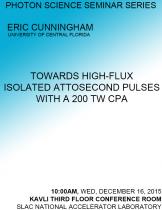Kavli Third Floor Conference Room
Speaker: Eric Cunningham, University of Central Florida
Program Description
Attosecond pulses have been developed as a means for investigating phenomena that proceed on the order of the atomic unit of time (24 as). Unfortunately, these extreme ultraviolet (XUV) pulses by themselves contain too few photons to initiate nonlinear dynamics or dress states in an attosecond pump–attosecond probe scheme. As a result, most attosecond experiments thus far have featured complementary near infrared (NIR) femtosecond lasers for instigating electron dynamics. In order to access the benefits of all-attosecond measurements and open attosecond physics to new fields of exploration, the photon flux of these pulses must be increased.
This talk will cover three areas of investigation focused on generating high-flux isolated attosecond pules suitable for all-attosecond experiments:
1) Scaling the peak power of the driving laser: One way to boost the attosecond pulse energy is to scale up the energy of the NIR pulse responsible for driving high-harmonic generation (HHG). At the Institute for the Frontier of Attosecond Science and Technology (IFAST) at the University of Central Florida, this scalability was demonstrated using a 350 mJ, 15 fs (10 TW) Ti:sapphire laser, which was used to generate a 100 nJ XUV continuum. To obtain the microjoule-level attosecond pulse energy required for performing all-attosecond experiments, this laser system was upgraded to provide joule-level output energies while maintaining pulse compression to 15 fs, with a targeted peak power of 200 TW.
2) Controlling the carrier-envelope phase of the driving laser: Because this system operates at a 10 Hz repetition rate, stabilization of the carrier-envelope phase (CEP) – important for controlling attosecond pulse production – could not be achieved using traditional methods. Therefore, a new scheme was developed in the IFAST lab, demonstrating the first-ever control of CEP in a chirped-pulse amplifier (CPA) at low repetition rates.
3) Optimizing the production of isolated attosecond pulses: Finally, a new variation of optical gating is proposed as a way to improve the efficiency of the attosecond pulse generation process. This method is predicted to allow for the generation of isolated attosecond pulses with longer driving laser pulses, as well as the extension of the high-energy photon cut-off of the XUV continuum.





